
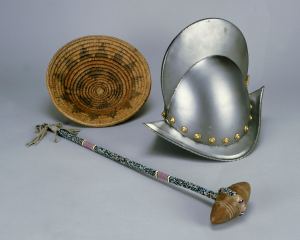
The Indian
ceremonial club, the Navajo basket, and the Spanish Conquistador helmet
symbolize the many centuries before 1881.
Before 1880
 |
|
|
The Indian
ceremonial club, the Navajo basket, and the Spanish Conquistador helmet
Before 1880 |
|
|
Mesa County's varied and
unique terrain was formed by nature�s forces through millions of years.
Here, the verdant Rocky Mountains meet the desert beauty of canyon country.
The area's first known humans arrived some 13,000 years ago. Native
Americans occupied the area for thousands of years; Spanish Padres, mountain
men and surveyors came to explore and record the region. Colorado became the Centennial State
in 1876. Three years later, an Indian uprising near Meeker led to the removal
of Ute Indians from the northern two-thirds of Western Colorado to
reservations in Utah. White settlers arrived in Mesa County in 1881. |
 |
GEOLOGY
In
ancient times, oceans and then deserts covered Western Colorado.
Their retreat left great deposits including sand, which compressed into
sandstone. To the west of Grand Junction, the red sandstone has
weathered into the canyons and elaborate formations of the Colorado
National Monument. East of the Grand Valley is the vast, flat-topped
Grand Mesa. Volcanic flows had covered that area, forming a protective
layer of hard basalt, hundreds of feet deep. The surrounding terrain
eroded away, leaving the Grand Mesa with its 10,000' elevation, forests
and lakes.
|
|
 |
|
|
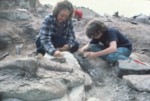 |
PALEONTOLOGY
Mesa
County has been the site of important fossil discoveries for over a
century. These include some of the largest, and some of the smallest
dinosaurs in the world. The earliest Brachiosaurus, and a largely intact
Apatosaurus are among the many significant dinosaur discoveries. The Bollan Stegosaurus, including tail spikes, was excavated at Rabbit Valley
by the Museum of Western Colorado. Mammal fossils of later
periods also are found, including mammoth and bison remains.
|
|
|
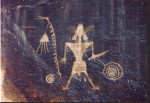 |
PREHISTORIC INDIANS
Traces
of Paleo Indians in Mesa County date to 11,000 B.C., and Archaic Indians to 8,000 B.C. Fremont Indians were here about 700 to 1200 A.D. They lived in
rock shelters and pit houses, which have yielded archaeological
material. Rock art was etched or painted on cliffs and boulders. This
example from the Fremont tradition is on a Mesa County ranch. The Fremonts
eventually moved away, probably to the Rio Grande Valley and its pueblos.
|
|
|
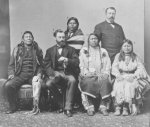 |
UTE
INDIANS
The Utes hunted over wide areas of Utah and Colorado. Some also had seasonal farms. Utes were noted for the fine ponies they raised and traded, and for their buckskin crafts. Ouray, born in 1833, became a tribal leader; his wife was Chipeta. The U.S. government accepted him as the chief Ute during treaty negotiations. In this 1880 photo, Ouray and Chipeta are on the front row.
|
|
|
 |
TRAILS
Indian trails were throughout Western Colorado. The Dominguez-Escalante
party used those trails while exploring a route from Santa Fe to
California. They came through Mesa County in August, 1776. A wagon road
developed which is called the Old Spanish Trail. This sign, at Eagle Rim
Park on Orchard Mesa, commemorates that trail and its ford across the
Colorado River.
|
|
|
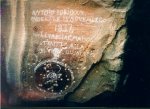 |
EXPLORERS
Fur
traders and mountain men ranged throughout Western Colorado, 1821-1845. Pictured is a
boulder, inscribed in French by trader Antoine Robidoux in
1837. He had an early trading post,
Fort Uncompahgre, near modern-day
Delta. Wayfarers included the Marcus Whitman party who came through the
valley in 1842. Lt. Edward Beale and Capt. John Gunnison headed two
separate exploration expeditions in 1853. The Hayden Survey teams of
1873-1876 surveyed, and named, many geologic features and peaks.
|
|
|
|
|
NEW TREATIES
In 1879, battles between the government and the Utes near Meeker, Colorado lead to old treaties being cancelled. The Utes were moved to reservations in Utah and Southwest Colorado, and our area was opened to settlement by non-Indians in September, 1881. Utes, however, were free to traverse the area during frequent treks between reservations. Pictured is a Ute who is visiting an early day Mesa County Fair.
|
|
|
|
|
If you have
arrived at this page from a search engine |
|